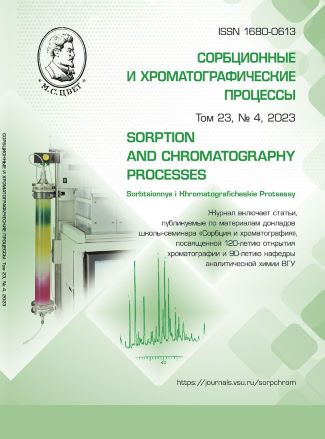Recurrent relations in chromatography
Abstract
One of the main features of first-order recurrent equations y(x + Dx) = ay(x) + b (Dx = const) is that they lead to a linear form of various monotonic functional dependencies, including chemical variables. Such unique capabilities of recurrent relations are due to the fact that they combine the properties of arithmetic and geometric progressions, and this explains the possibility of linearisation of various retention time dependencies, both in gas and high-performance liquid chromatography (HPLC). Examples of the use of recurrent relations to characterize the dependence of analyte retention times on temperature in gas chromatography and on the concentration of organic components of eluents in reversed-phase HPLC are considered. They are effective in approximating variations in the retention indices of homologues and congeners depending on their position in the corresponding taxonomic groups of organic compounds. Moreover, based on the linearity of the recurrent dependence of the retention indices of analytes of various groups, it can be assumed that they belong to homologues or congeners. This identification option is illustrated by the example of previously unknown products of partial hydrolysis of tetraethoxysilane – triethoxysilanol, diethoxysilanediol and ethoxysilanetriol.
Deviations of the recurrent approximation of retention parameters from linearity are also informative. This form of comparison of gas chromatographic retention indices of homologues allows identifying steric interactions in molecules, as illustrated by the example of a series of methyl-substituted benzenes. Recurrent approximation of the retention indices of benzene, toluene, m-xylene (1,3-dimethylbenzene) and mesitylene (1,3,5-trimethylbenzene) are linear, while the retention index of sterically strained isodurol (1,2,3,5-tetramethylbenzene) does not correspond to this dependence. In reversed-phase HPLC, the recurrent representation of the dependence of the retention times of analytes on the content of the organic component of the eluent allows identifying the shift in the positions of acid-base equilibria in solutions. In addition, the deviations of recurrent approximations of retention times from linearity in regions with high water content in the eluent allows detecting the reversible formation of hydrates of the analysed compounds.
Downloads
References
Zenkevich I.G. Application of recurrent relationships in chromatography. J. Chemo¬metrics. 2009; 23: 179-187. https://doi.org/10.1002/cem.1214
Handbuch der Gaschromatographie. Eds. E. Leibnitz, H.G. Struppe. Leipzig: Akade¬mishe Verlagsgesellschaft Geest & Portig K.-G. 1984. 828 p.
Row K.H. Comparison of retention models for the dependence of retention factors on mobile phase composition in reversed-phase high-performance liquid chromatography. J. Chromatogr. A. 1998; 797: 23-31. https://doi.org/10.1016/S0021-9673(97)00969-2
Soczewinski E. Mechanistic molecular model of liquid-solid chromatography reten¬tion-eluent composition relationships. J. Chromatogr. A. 2002; 965: 109-116. https://doi.org/10.1016/S0021-9673(01)01278-X
Soczewinski E, Wachtmeister C.A. The relation between the composition of certain ternary two-phase solvent systems and RM values. J. Chromatogr. 1962; 7: 311-320. https://doi.org/10.1016/S0021-9673(01)86422-0
Snyder L.R, Dolan J.W. The linear-solvent-strength model of gradient elution. Adv. Chromatogr. 1998; 38: 115-187. https://doi.org/10.1201/9781003210313-4
Schoenmakers P.J, Billiet H.A.H, Tijssen.R, Galan. L.De. Gradient selection in rever¬sed-phase liquid chromatography. J. Chromatogr. A. 1978; 149: 519-537. https://doi.org/10.1016/S0021-9673(00)81008-0
Zenkevich I.G. Approximation of any physicochemical constants of homologues with the use of recurrent functions. J. Math. Chem. 2009; 46: 913-933.
Zenkevich I.G. Application of recurrent relations in chemistry. J. Chemometr. 2010; 24: 158-167. https://doi.org/10.1002/cem.1297
Zenkevich I.G. Approximation of physicochemical properties of homologs using recurrent and related non-recurrent relations. J. Chemometr. 2012; 26(3-4): 108-116. https://doi.org/10.1002/cem.1419
Zenkevich I.G. Mathematical transformations of recurrent relations for different types of homologues. J. Chemometr. 2016; 30: 217-225. https://doi.org/10.1002/cem.2796
Zenkevich I.G. Recurrent Relationships in Separation Science. In “Chemometrics in Chromatography” Eds. L. Komsta, Y.V. Hey¬den, J. Sherma. New York: Taylor & Francis. 2017. Ch. 24: 449-468.
The NIST Mass Spectral Library (NIST/EPA/NIH EI MS Library, 2017 Release). Soft-ware/Data Ver¬si¬on; NIST Standard Reference Database, Number 69, August 2017. Na¬ti¬onal Insti-tute of Standards and Techno¬logy, Gaithersburg, MD 20899: http://webbook.nist.gov (Accessed: April 2023).
Peterson M.L, Hirsch. J. A calculation for locating the carrier gas front of a gas-liquid chromatogram. J. Lipid Res. 1959; 1: 132-134.
Zenkevich I.G., Baranov D.A. Gas-chromatographic identification of unusual unstable products of partial hydrolysis of tetraethoxysilane. J. Anal. Chem. (Rus.). 2023; 78(1): 67-75. https://doi.org/10.1134/S1061934823010148
Zenkevich I.G., Nikitina D.A. Features of the recurrent approximation of retention parameters of polyfunctional compounds in RP HPLC. Rus. J. Phys. Chem. A. 2021; 95(2): 395-402. https://doi.org/10.1134/S003602442102028X
Zenkevich I.G., Nikitina D.A., Kornilova T.A. Recurrent approximation of reten¬tion para-meters of N-substituted p-toluenesulfonami¬des in reversed-phase high per¬for¬mance li¬quid chromatography for revealing the for¬ma¬tion of their hydrates. Rus. J. Phys. Chem. A. 2021; 95(9): 1923-1933. https://doi.org/10.1134/S0036024421090326
Zenkevich I.G., Derouiche A., Nikitina D.A. Detection of organic hydrates in re¬versed phase high performance liquid chromato¬graphy using recurrent approximation of their retention times. J. Liquid Chromatogr. Related Technol. 2021; 44(11-12): 588-598. https://doi.org/10.1080/10826076.2021.1998905
Zenkevich I.G., Nikitina D.A., Derouiche A. Revealing the hydration of sorbates based on the dependence of their retention parameters in reversed-phase HPLC on the concentration of the organic component of the eluent. Protect. Metals Phys. Chem. Surf. 2022; 58(6): 1156-1163. https://doi.org/10.1134/S2070205122060223
Zenkevich I.G. Derouiche A., Nikitina D.A. Evidence for the hydration of some organic compounds during reverse-phase HPLC analysis. Molecules. 2023; 28(2): 1-19; 734. https://doi.org/10.3390/molecules28020734







